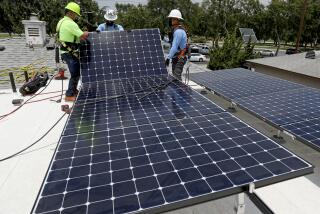Opinion: Lesson for California: Before expanding solar energy, figure out a way to store it.

To the editor: Your article correctly reports that California generates and pays for more electricity than it currently needs. But the “why” is dim by more than a few watts. (“California invested heavily in solar power. Now there’s so much that other states are sometimes paid to take it,” June 22)
Peak daily electrical use occurs when people come home from work, from 4 p.m. to 7 p.m., just when solar power generation starts shutting down with the setting sun. The question is not why are we continuing to invest in and operate gas-fired generation, but why did state politicians force conversion to solar generation with no way to store the electricity needed to meet peak daily demand?
I strongly support California’s shift to renewable electrical generation, but we must stop playing the blame game over what’s causing our energy glut and instead support the research and financial incentives needed to build the large-scale electrical storage needed to complete the job.
Kris Bonner, Mission Viejo
The writer is a retired energy consultant.
..
To the editor: The Times points out a glaring weakness in our energy system. Despite commendable, large investments in renewable energy, the state has only just begun investments in large scale storage. Batteries are an important part of the solution of using our excess energy rather than dumping it at a loss.
A lot of California’s electricity challenges are the result of policy missteps.
— Bob Hoffman, energy consultant
Another important investment, which has proven to be successful in Germany and most recently in a pilot project at UC Irvine, is power to gas. Excess renewable energy can be used to break down water into hydrogen and oxygen through hydrolysis, with the end result being a carbon-free fuel (hydrogen) that can be used directly for powering vehicles or for energy storage.
Hydrogen can be co-mingled with natural gas safely at a ratio of up to 20%, yet the state has not moved forward on incentivizing these kinds of projects on a large scale. This needed transformation in California’s energy management system would eliminate the wasteful practice of dumping valuable renewable energy and move California more quickly to a decarbonized energy future.
Mark Gold, Santa Monica
The writer is UCLA’s associate vice chancellor for environment and sustainability.
..
To the editor: Our electric markets could do a better job managing surpluses. Energy going to waste is no different than not eating every scrap of food on your plate. We are not calling on a moratorium on new grocery stores because of food waste.
Electricity has two measurable attributes: capacity (ability to supply) and energy (the delivered stuff). Power systems need capacity to support hourly changes in energy needs, and local gas-fired power plants are like fire stations, which are idle most of the time and respond when we need them. Older plants need to be replaced with fast-responding flexible resources.
A lot of California’s electricity challenges are the result of policy missteps. A balanced mix of power resources providing capacity to cover our diverse energy demands is needed to assure electric resiliency, just as we hope grocery stores stick around for when we need them.
Bob Hoffman, Redondo Beach
The writer is an energy consultant.
..
To the editor: The article about paying to send energy to surrounding states was interesting. I couldn’t find any information about reducing California electricity-user rates when there is a glut of energy here.
We have found ways to let people know when there’s a person abducted through phone and highway sign alerts. Why can’t we alert electricity users when there is a glut?
We try not to use our air conditioners much during peak usage hours; shouldn’t we be alerted when a glut of electricity might make it OK to cool down?
Steve Mattern, Corona
Follow the Opinion section on Twitter @latimesopinion and Facebook
More to Read
A cure for the common opinion
Get thought-provoking perspectives with our weekly newsletter.
You may occasionally receive promotional content from the Los Angeles Times.






